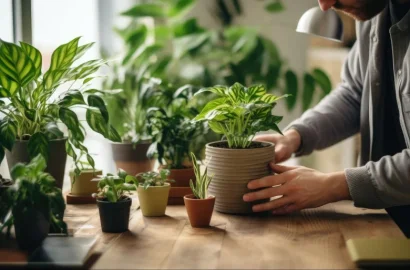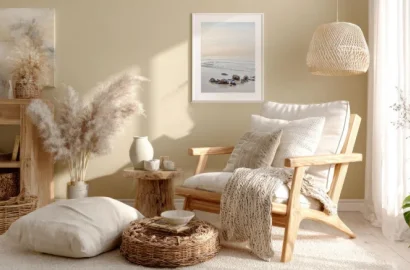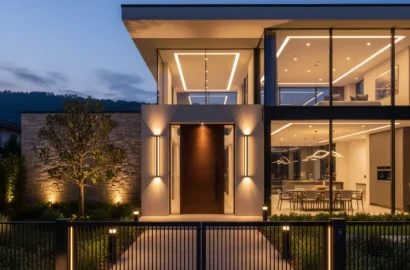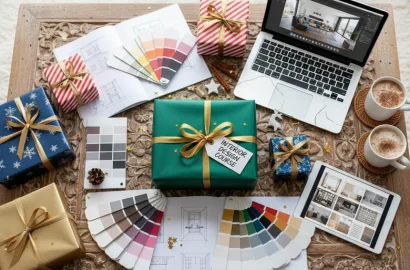Looking for advice on crafting the perfect interior design resume? Check out our step-by-step guide to creating a resume that will help you land your next interior design position.
A critical tool for demonstrating skills, experience, qualifications, and career trajectory, an interior designer’s resume is of paramount importance in capturing the attention of potential employers, clients, and recruiters. An interior designer’s resume acts as a snapshot of their professional portfolio, highlighting creative achievements and expertise and effectively communicating the ability to meet company goals, project objectives, and each client’s needs. A well-crafted resume can help an interior designer stand out from the competition and secure them creative and rewarding professional opportunities and roles.
In this article, we’re going to run you through exactly what it takes to create an interior design resume that will get you noticed by employers and help you land your next position.
This is what we’ll be covering:
- How to craft the perfect interior design resume
- Which format should I use for my interior design resume?
- How do I customize a resume to my level of experience?
- How do I showcase my interior design portfolio within a resume?
Ready to find out how to do it? Then keep reading.
1. How to craft the perfect interior design resume
If you’re applying for jobs as an interior designer, we’ve got the guide you need. From writing your summary statement to outlining your contact details, skills, and employment history, we’ve put together six simple steps to help create a resume that will ensure you stand out from the competition.
Write an objective or summary statement
A summary statement on your interior design resume is a short paragraph that provides potential employers and recruiters with details of your skills, previous jobs, and key achievements in the field. It’s an important snapshot of your experience and work history as an interior designer and helps to build a picture of your professional background and seniority at a glance. As a job applicant for an interior design position, your goal here is to grab an employer’s attention and provide a concise and compelling overview of why you are the right person for the position being advertised.
Elements to consider including in your summary statement include:
- The name of your current position or the professional title you are targeting (e.g, Senior Interior Designer)
- The number of years of interior design work experience that you have
- Your key interior design skills and strengths, including both soft and technical skills
- Any notable achievements, such as interior design course certification or proof of training
- Your career goals or any work objectives you’d like to meet in your next role

Include a skills section
You want to make it as easy as possible for employers to see what skills you possess so they can quickly assess your suitability for the role they are trying to fill. Including a skills section on your interior design resume makes it much easier for them to do this. Your skills section is an opportunity to showcase your talents and technical proficiencies as well as highlight the skills that match the skills required by the person recruiting.
Here are the main skills and proficiencies that employers recruiting interior designers will want to see in this section of your resume:
Soft skills
- Creativity
- Attention to detail
- Planning, management, and organization
- Communication skills
- Collaboration skills
- Presentation skills
Technical skills and knowledge
- Knowledge of interior design principles
- Knowledge of sustainable practices
- Sketching skills
- Knowledge of computer-aided design (CAD)
- Knowledge of current trends
- Space planning
- Colour theory
- Interior architecture
- Rendering
- Design concept development
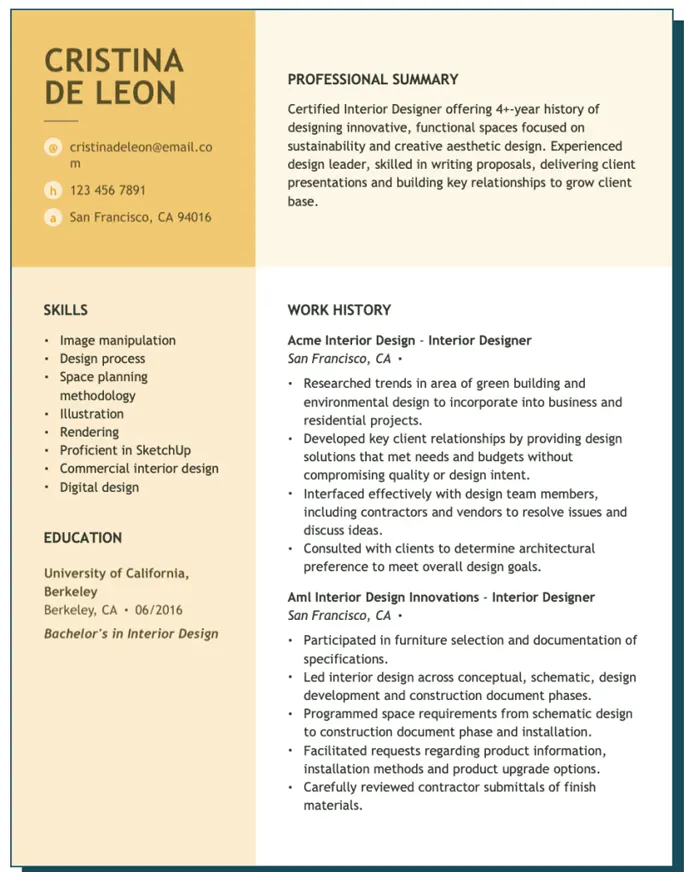
Include your contact information
Don’t forget to include your contact information on your resume! Without these key details, potential employers won’t be able to get in touch about an interview, ask follow-up questions, or provide updates about your application’s status. Be sure to include this information in bold, clear text that is easy to find on your resume (for example, right at the top of the page, close to your name). Remember, the easier it is for employers to contact you, the higher the chances are that they will.
So, what should you include? We’d recommend the following:
- Full name
- Phone number
- Email address
- LinkedIn profile
- Relevant social media channels that you use for professional purposes, for example: Instagram or Pinterest
- Link to your professional portfolio website
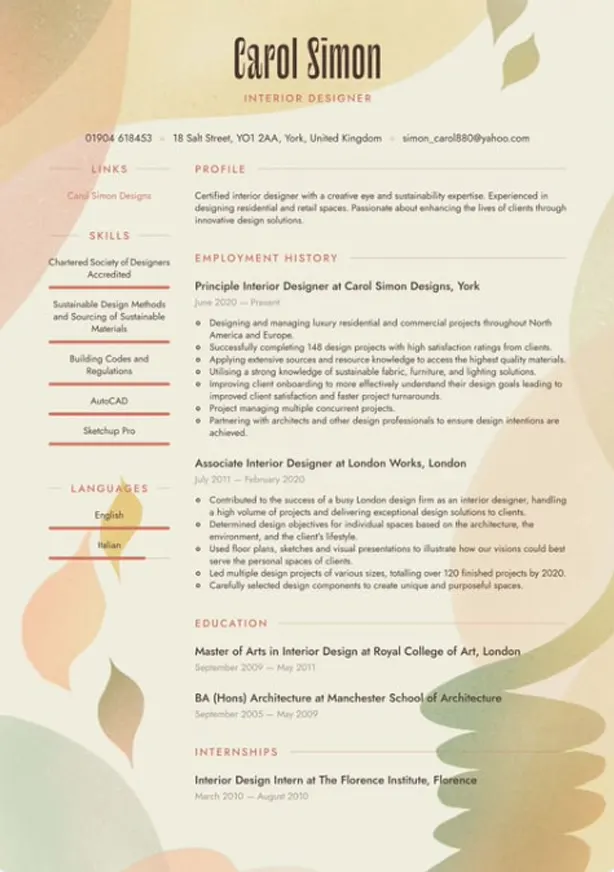
Add in professional experience
The main bulk of your resume will consist of details of your relevant employment history. Usually presented chronologically, this section should provide employers and recruiters with a succinct overview of your career, highlighting your job titles, key responsibilities, and achievements in interior design. Although it can be tempting to include every job you’ve ever had, it’s important in this section to be selective. Refer back to the job description to see what the role requires before including roles that indicate you would be a good match.
Here’s a rundown of what you should include in the professional experience section of your interior design resume:
- Job titles starting with your most recent or current position
- Names of companies or design firms where you’ve worked
- Start and end dates (including the month and the year) for each position
- Job descriptions, including where possible:
- A brief outline of the role
- Responsibilities
- Achievements
- How your work contributed to the overall team or company success
- Notable projects or clients
- Software and tools used in your roles
- Any awards, recognitions, or special achievements related to your interior design work.

Image Source: Behance
Include a portfolio section
The portfolio section is undoubtedly the most important part of your interior design resume. There are a few different reasons for this, the main one being that in such a highly visual and creative field employers will want to see tangible proof of your interior design experience before considering you for an interview. In addition to showcasing the breadth and depth of your design work, your interior design portfolio is a place to:
- Demonstrate specific skills such as space planning and 3D modeling
- Highlight your creativity and innovative thinking
- Underscore your experience with different clients and with different projects
- Showcase your technical proficiency with technical drawings, renderings, and floor plans
Whether you choose to include a link to a professional portfolio website or display a selection of visuals directly into the resume, here’s what your portfolio will need to include:
- Project overview
- For each project include an overview outlining its goals, scope, and any challenges which you were presented with
- Remember to include context, such as whether the project was residential or commercial
- Images
- For each project, you’ll need to include high-quality images of completed projects.
- You might want to consider including before and after photographs to demonstrate the transformation of the space
- Technical drawings
- Where you have them, include technical drawings and floor plans to demonstrate your familiarity and proficiency with design software
- 3D renderings
- 3D renderings will help convey how you intended the space to look in the design stage, as well as demonstrate your technical ability with 3D rendering software
- Color schemes
- You may want to show samples of color schemes used in a project
- Client testimonials
- Positive feedback or quotes from clients convey your professionalism and the success of your projects
- A diverse selection of projects
- Try to include a variety of interior design projects to demonstrate your ability to meet a broad range of client needs, work with different materials, and successfully complete projects for different industries.
- Well presented
- Your portfolio should be organized in a manner that is seamless to navigate, with projects displayed in an order that makes sense to visitors or readers.

(Source)
Include your education and certifications
While the work experience, skills, and portfolio sections of your resume will for many interior designers take priority, the education and certifications section should not be overlooked or forgotten. This important section serves to validate a designer’s theoretical knowledge of the field and confirm any formal training they’ve undertaken. It can also be used to highlight any specialist skills or areas of interest. For interior design beginners, proof of education can be seen as a key differentiator between job candidates, while for more senior-level interior designers, this information demonstrates their commitment to staying up-to-date with industry trends and technologies in a rapidly evolving field.
Here’s what to include in the education and certificates section of your interior design resume:
- Education section:
- Degree earned
- Major (if applicable)
- Educational institution
- Date of graduation
- Certifications section:
- Certification name
- Issuing school, university, or organization
- Date obtained
- Additional training, workshops, or short courses
Outline the tools you are familiar with
Demonstrating your tools knowledge on your interior design resume provides employers and recruiters with a tangible representation of your technical abilities. With this knowledge, they can calculate your technical competence and whether or not any additional training might be needed should you be offered the position. Those who can demonstrate technical prowess with cutting-edge and latest interior design software will be at an advantage over candidates who can’t. Not only does this section show a commitment to professional and continuous learning, these candidates will likely be able to achieve results faster too.
Tools that employers will want to see on a mid-level interior design resume are:
- AutoCAD
- SketchUp
- Autodesk
- Adobe Creative Suite (Photoshop, InDesign, Illustrator)
- Microsoft Office Suite
- V-Ray
- Lumion
- 3ds Max

2. Which format should I use for my interior design resume?
You have a few options open to you when it comes to formatting your interior design resume. The three most popular layouts are chronological, functional, and combination.
A chronological resume format is probably the most common layout choice used by interior designers. This format sees designers display their professional experience in reverse chronological order; this means they place their most recent positions first, at the top of the page, and work backward. The advantage of adopting this resume format is that employers can quickly and easily see an individual’s career progression as well as their suitability for the role being advertised.
Unlike a chronological interior design resume, a functional resume format does not display work experiences in reverse chronological order but instead offers a layout that emphasizes specific skills and qualifications first. While most employers prefer a chronologically formatted interior design resume, a functional resume format can be advantageous to those who have gaps in their employment history or those who are making a career change and do not yet have significant work experience in the field.
As the name implies, a combination interior design resume format contains elements of both functional and chronological layouts. With this format, designers have the opportunity to highlight their skills and achievements while still presenting their employment history and work experience in reverse chronological order. This format is advantageous to those who want to draw attention to specific skills or accolades that might not be immediately evident on a resume that is purely chronological, while still making it easy for employers to swiftly digest their work history and career progression.
3. How do I customize a resume to my level of experience?
There’s no one-size-fits-all approach to creating a resume; each professional needs to customize their resume to accurately reflect their level of experience and education in the field. To do this, you’ll need to highlight the most relevant elements of your professional journey and career trajectory. For entry-level interior designers, this means drawing an employer’s attention to your educational background and training, any internships undertaken, pieces of coursework you are proud of, and projects that showcase foundational skills and knowledge. A good reference point here could be AND learner Monica Reddy’s Residential Project. For mid-level interior designers, it’s important that your resume shows the diversity of your skill set, your work on a broad range of projects, and your growing expertise in certain key areas. It will also be important to demonstrate your commitment to continuous learning and professional training in the field and your ability to stay abreast of trends and changes. For senior-level interior designers, leadership experience, team and project management skills, the successful execution of projects, wide-ranging interior design skills and experience, and any industry awards, prizes, or recognition should be underscored in your resume.
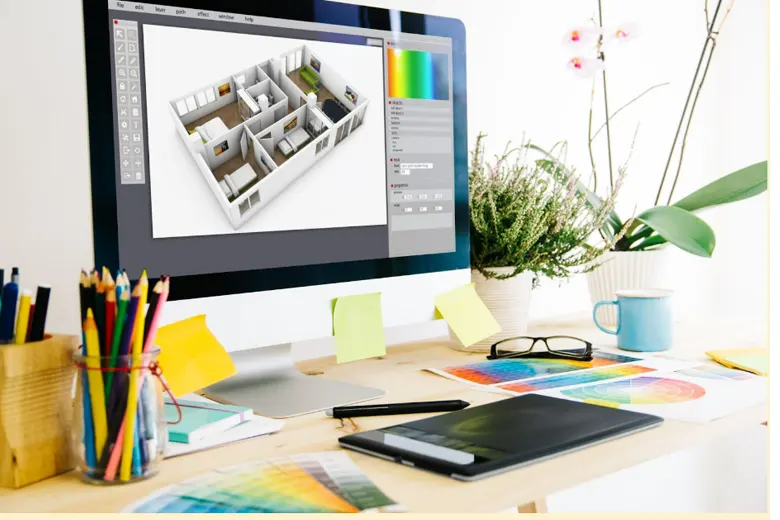
4. How do I showcase my interior design portfolio within a resume?
There are a few different ways to showcase your professional portfolio within your resume. While some people choose to provide a link to their online portfolio in the contact information section of the resume or underneath their name at the top of the page, others create a dedicated section within the resume that features portfolio highlights; photographs of projects, brief descriptions, and links to more information (usually their online portfolio). For those submitting a physical resume, another option is to include a QR code which employers and recruiters can open with a QR code reader to seamlessly access an online portfolio of work.
5. Conclusion
We hope you’ve enjoyed this rundown of how to create an interior design resume and have found some inspiration for your own resume from the examples we’ve provided here.
Some final tips:
- As a designer, it’s important to create a portfolio that is visually appealing. Consider using color and images to improve readability and to demonstrate your creativity without distracting from the information you are trying to get across.
- Keep your descriptions short and use language that is succinct and to the point.
- Draw attention to the career highlights that you are most proud of.
- Highlight relevant interior design training and education that underscores both your industry knowledge and your commitment to building on your skills.
- Avoid including work experience that is not relevant to the role you are applying for.
Next Steps
If you’d like to learn more about the interior design industry or how to land a role in the field, head back to our blog for more articles like this one! In case you are looking for further assistance, here are some additional resources you can refer to:
- Watch this session by graphic design industry leaders Soumya Tiwari and Sakshi Jain.
- Talk to a course advisor to discuss how you can transform your career with one of AND Academy’s courses.
- Explore our Graphic Design Course, which is taught through live, interactive classes by industry experts, and comes with a job guarantee.
- Take advantage of the scholarship and funding options that come with our courses to overcome any financial hurdle on the path of your career transformation.
Note: All information and/or data from external sources is believed to be accurate as of the date of publication.



